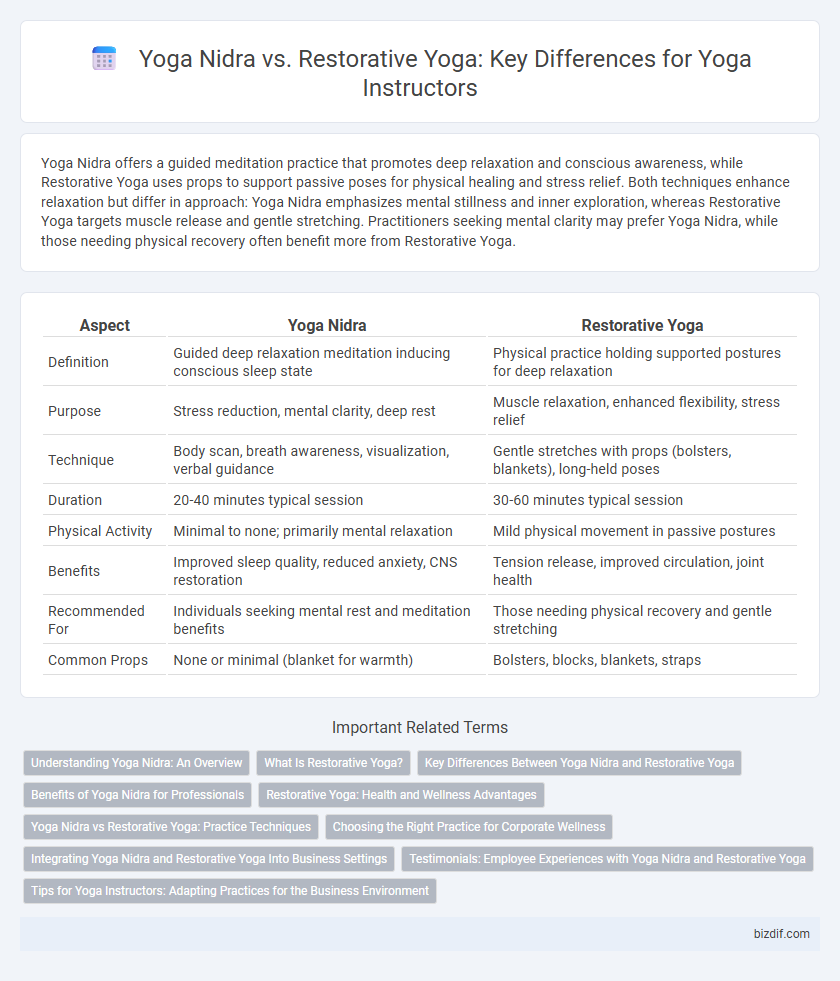Yoga Nidra offers a guided meditation practice that promotes deep relaxation and conscious awareness, while Restorative Yoga uses props to support passive poses for physical healing and stress relief. Both techniques enhance relaxation but differ in approach: Yoga Nidra emphasizes mental stillness and inner exploration, whereas Restorative Yoga targets muscle release and gentle stretching. Practitioners seeking mental clarity may prefer Yoga Nidra, while those needing physical recovery often benefit more from Restorative Yoga.
Table of Comparison
| Aspect | Yoga Nidra | Restorative Yoga |
|---|---|---|
| Definition | Guided deep relaxation meditation inducing conscious sleep state | Physical practice holding supported postures for deep relaxation |
| Purpose | Stress reduction, mental clarity, deep rest | Muscle relaxation, enhanced flexibility, stress relief |
| Technique | Body scan, breath awareness, visualization, verbal guidance | Gentle stretches with props (bolsters, blankets), long-held poses |
| Duration | 20-40 minutes typical session | 30-60 minutes typical session |
| Physical Activity | Minimal to none; primarily mental relaxation | Mild physical movement in passive postures |
| Benefits | Improved sleep quality, reduced anxiety, CNS restoration | Tension release, improved circulation, joint health |
| Recommended For | Individuals seeking mental rest and meditation benefits | Those needing physical recovery and gentle stretching |
| Common Props | None or minimal (blanket for warmth) | Bolsters, blocks, blankets, straps |
Understanding Yoga Nidra: An Overview
Yoga Nidra is a guided meditation practice that induces deep relaxation and heightened awareness through systematic body scanning and breath awareness. Unlike Restorative Yoga, which uses physical props to support passive poses for physical relaxation, Yoga Nidra primarily targets the nervous system to release stress and enhance mental clarity. This practice promotes a state between waking and sleeping, fostering profound inner peace and healing beyond conventional rest.
What Is Restorative Yoga?
Restorative yoga is a gentle practice centered on passive poses supported by props to facilitate deep relaxation and stress relief. It emphasizes long holds, often lasting several minutes, allowing muscles to release tension without effort while calming the nervous system. The primary goal is to restore energy and promote healing through mindful, slow-paced movements and breath awareness.
Key Differences Between Yoga Nidra and Restorative Yoga
Yoga Nidra emphasizes guided meditation and deep relaxation to access a state between wakefulness and sleep, promoting mental clarity and stress relief. Restorative yoga uses gentle physical postures supported by props to release tension and enhance physical restoration through passive stretching. The key difference lies in Yoga Nidra's focus on mental relaxation and meditation, while Restorative yoga centers on physical recovery and gentle movement.
Benefits of Yoga Nidra for Professionals
Yoga Nidra offers profound mental clarity and stress reduction, making it ideal for professionals managing high-pressure environments. This guided meditation technique promotes deep relaxation, enhances focus, and improves sleep quality, which supports cognitive function and productivity. Compared to Restorative Yoga, Yoga Nidra requires less physical effort, enabling busy professionals to achieve restorative benefits without extended time commitments.
Restorative Yoga: Health and Wellness Advantages
Restorative Yoga offers profound health and wellness benefits by promoting deep relaxation and reducing stress through gentle, supported poses held for extended periods. This practice enhances flexibility, improves circulation, and supports the parasympathetic nervous system, aiding in better sleep quality and emotional balance. Unlike Yoga Nidra, which is a guided meditation technique, Restorative Yoga emphasizes physical rest and recovery, making it ideal for healing chronic pain and boosting immune function.
Yoga Nidra vs Restorative Yoga: Practice Techniques
Yoga Nidra utilizes guided meditation techniques to induce deep relaxation and conscious awareness, often practiced lying down while remaining mentally alert. Restorative Yoga employs physical props such as bolsters and blankets to support passive poses that promote physical relaxation and gentle stretching. The practice of Yoga Nidra centers on mental relaxation and visualization, whereas Restorative Yoga emphasizes bodily release through sustained, supported postures.
Choosing the Right Practice for Corporate Wellness
Yoga nidra offers deep guided relaxation that reduces stress and enhances mental clarity, making it ideal for corporate wellness programs targeting employee burnout. Restorative yoga emphasizes gentle poses with props to release physical tension and improve flexibility, supporting overall workplace health and reducing musculoskeletal pain. Selecting between these practices depends on company goals: Yoga nidra for mindfulness and cognitive restoration, restorative yoga for physical recovery and relaxation.
Integrating Yoga Nidra and Restorative Yoga Into Business Settings
Integrating Yoga Nidra and Restorative Yoga into business settings enhances employee well-being by promoting deep relaxation and reducing stress-related absenteeism. Yoga Nidra, a guided meditative practice, complements Restorative Yoga's gentle postures to facilitate mental clarity and physical rejuvenation during work breaks. Implementing these practices in corporate wellness programs supports productivity and fosters a mindful workplace culture.
Testimonials: Employee Experiences with Yoga Nidra and Restorative Yoga
Employees practicing Yoga Nidra report profound mental clarity and stress relief, emphasizing its effectiveness in enhancing focus and emotional balance during work hours. Testimonials highlight Restorative Yoga's impact on physical relaxation and muscle recovery, with workers noting reduced tension after long shifts. Both practices contribute uniquely to workplace wellness, offering complementary benefits for mental and physical rejuvenation.
Tips for Yoga Instructors: Adapting Practices for the Business Environment
Yoga instructors can enhance client experience by tailoring Yoga Nidra sessions to promote deep mental relaxation through guided meditation, while Restorative Yoga should focus on gentle poses supported by props to alleviate physical tension. Emphasizing clear verbal cues and maintaining a calm, soothing environment assists in managing diverse stress levels common in business settings. Incorporating time-efficient practices and encouraging mindful breathing techniques helps professionals effortlessly integrate relaxation into their busy schedules.
Yoga nidra vs Restorative yoga Infographic

 bizdif.com
bizdif.com